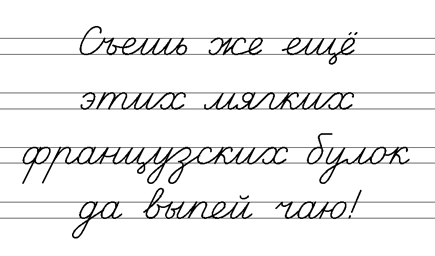Добро пожаловать в лингафонную общину!!
Welcome to Elementary Russian in the Language Commons!
Today we're working on some basic competencies like handwriting, alphabet, listening skills, and counting. You can do this lab in the Language Commons, or wherever. (In case you missed it, here are some resources for learning the Russian alphabet.)Make sure you have a lab worksheet ! They're available in the lab, or you can print them out for remote work. (Did you know there are free printers all over campus?)
Every lab begins with individual, computer work like watching videos, listening to recordings, etc.
First:
Check out this illustration from Leo Tolstoy's primer, published in the 1870s to help schoolchildren learn to read print and cursive. It's the letter "m" in various typefaces (fonts) and cursive, and a word that readily comes to mind that starts with "m": медведь, bear.
Съешь же ещё этих мягких французских булок да выпей чаю!
is written out by hand, in cursive. like this:

Eat these soft French buns and drink some tea!
That's all the letters in the Russian alphabet... probably the shortest iteration, like our "Quick brown fox"... (The word же doesn't really mean anything, it's like, "you know" in English, which mostly doesn't mean "you know." It emphasizes the verb that precedes it, here, "eat", съешь.) A few things to notice: 1) Not many letters are tall, rising above the middle line. 2) Several of the letters (л, м, я) have "hooks" incorporated into their shape that help differentiate them from other letters. 3) Most of the cursive letters look like the print letters, with the real exception of the letter т (tee), which looks like an "m" (examine the word этих, second line, second letter... looks like an "m" doesn't it?) Like English cursive, Russian cursive MOSTLY looks like Russian print.
You have four short exercises. It should take you 15 minutes. You need to get this worksheet checked... Either by your instructor or a tutor... There are lots of ways to do this, like bringing it to class, finding a tutor, sending it to your instructor by email (take a picture on your phone!), etc. You're smart... you'll figure it out.
Worksheet stuff...
Listen to Числительные (Numerals)... Прослушайте! Ех А, Б, В. These are the THREE exercises (first page) on your lab worksheet, starting with the exercise ""You will now learn numbers..." (We know... some of these are just listening exercises and don't require you to write anything... Listening!)
Finished? Закончили? А теперь... And now, Listen to the list of PRIZES! and check off the ones named on your worksheet...
Now, let's do some reading. Go over Alphabet Lesson 2, Alphabet Lesson 3, and Alphabet Review (you might not be able to do it all today, however, do it by Friday). Send me the screenshots of the last slides from each lesson.
Handwriting (aka cursive, по-русски пропись)
On the handout you'll find the phrase from above (the one about French rolls), repeated five times with lines that will help you with size and slant. The best way to learn cursive is... you guessed, copying out phrases. The one on your sheet includes all the letters in the Russian alphabet in its shortest iteration.
WATCH this YouTube series of videos detailing the correct (but not the only way!) to make your буквы (letters)... Some letters are more difficult to perform than others. Here are the most difficult letters to write out:
The letter Кк (kay)
The letter Жж (zhe)
The letter Хх (kh)
The letter Ыы (ee)
Practice copying out the phrase on your worksheet. Watch the videos for help in how to draw them, if you need it. And bring the completed worksheet to class and/or to a tutor or instructor, who can help you out!
If you need help with anything, just give us a shout!
snezhana.zheltoukhova@gmail.com
Or reach out to a tutor! Ирина или Актан


